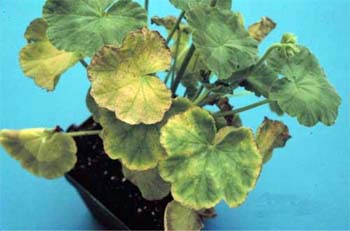Low pH symptoms showing up on geraniums in greenhouses
Greenhouse growers can avoid these symptoms of low pH on geraniums by monitoring for pH. Remedies include changing fertilizer types and adding lime applications to solve the problem.
Every year we receive a frantic phone call from a greenhouse grower or two that has a problem with geraniums either from seed or cuttings that have some marginal necrosis, edge burn and speckling of foliage, and have overall poor growth. Similar symptoms can appear on marigold. In most cases, the roots are white and appear healthy, so root rots are usually ruled out as a cause of the problem.
Routine checking of the media pH reveals that the problem is often from a low media pH. A pH below 6.0 is not acceptable for geranium growth. At that low pH, the plant takes up high levels of iron and manganese, which leads to burned and speckling leaves. Often times the symptoms show up first on certain colors like violet, pink, and white before the red ones start to show the problem.

Low pH symptoms of geranium. Photo credit: Douglas Cox, Univ. of Massachusetts.
To avoid this problem, growers need to be sure that the starting pH of their geranium growing media is at least 6.0 when they transplant liners or plugs into the final containers. Check pH with your meter weekly if possible. It seems like every year, some company fails to put the proper lime charge into some batches of their product due to worker error or equipment failure. As a result, the unsuspecting grower can end up with a low pH problem with geraniums.
If you have a pH below 6.0, consider switching to an alkaline fertilizer like 15-0-15, 14-2-14 or similar analysis to help raise your media pH. This is especially true if you had been using an acid-forming fertilizer like 20-10-20 or 21-5-20. In addition, you may need to apply lime to the container in the form of “flowable limestone” at the rate of 4 qt/100 gal. At that rate, flowable lime can raise the media pH by a full point if applied properly. Most of the effect of flowable lime occurs within a day, but the full effect is not achieved until about a week later, so be patient.
Once the pH moves above 6.0, the plants will resume normal growth and development. You may have to remove the damaged leaves, as they can be unsightly at the retail sales location.
For more tips on applying the flowable lime and to learn more about how a low pH causes problems on geraniums, read “’Iron-Out’: A nutritional program for geraniums and other crops prone to iron and manganese toxicity at low media-pH” by Paul R. Fisher and William R. Argo from the University of New Hampshire Cooperative Extension.



 Print
Print Email
Email



